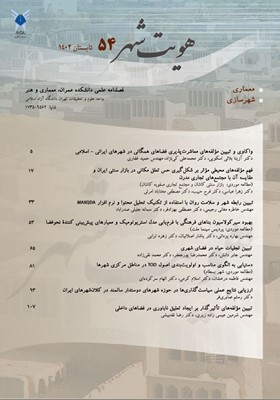تبیین مؤلفههای تأثیرگذار بر ایجاد تعلیق ناباوری در فضاهای داخلی
محورهای موضوعی : معماریشرمین عیسی زاده زیری 1 , رضا نقدبیشی 2 *
1 - دانشآموخته، کارشناسی ارشد معماری داخلی، گروه معماری، دانشکده هنر و معماری، واحد تهران جنوب، دانشگاه آزاد اسلامی
2 - استادیار، گروه معماری، دانشکده هنر و معماری، واحد رودهن، دانشگاه آزاد اسلامی، تهران، ایران
کلید واژه: کاتارسیس, روایتگری, تعلیق ناباوری, فضای داخلی,
چکیده مقاله :
جهان حاضر با تحمیل محدودیتهای خود، انسان را ناگزیر به پناه بردن بر جهانی ساخته ذهن و مبتنی بر رؤیا میسازد تا لحظاتی را در آرامش سپری سازد که این مهم در ادبیات نمایشی و سینما با مفهوم تعلیق ناباوری ممکن میگردد. معماری بهعنوان هنری دیرباز و معمار باهدف اولیه خود که برانگیختگی احساسی در کاربر فرای خلق فضاهای کاربردی است، میتواند با طراحی فضاهایی ماورا تصورات، الگوهای طراحی بدیعی را در این حوزه وارد نماید. هدف در این پژوهش شناسایی عوامل اثرگذار بر ایجاد تعلیق ناباوری در فضاهای داخلی است. بر اساس شاخصهای واکاوی شده و با اتکاء به مدلسازی مفهومی، سنجش نمونههای موردی از طریق کمّیسازی و تحلیل یافته ها بر اساس طیف لیکرت، هفت معیار و بیست و چهار شاخص دستهبندی گردیده و راهکارهای طراحی و نحوه اثربخشی آنها بر کاربر موردبحث قرار گرفتهاند که بهکارگیری آنها در معماری فضاهای داخلی میتواند منجر به ورود کاربر به جهانی ماورا تصورات گردد.
The world imposes numerous limitations that cause humans to harbor worlds created by the mind and made up of dreams to spend some time in peace. It is enabled in dramatic literature by the suspension of disbelief concept. Suspension of disbelief is the avoidance of critical thinking or logic in examining something unreal or impossible in reality, such as a work of speculative fiction that Samuel Taylor Coleridge first introduced this English-language term in 1817. Architecture, an ancient art form, and architects, with their primary goal of evoking emotions in users, can introduce novel design patterns in this area by creating spaces that are beyond imagination. Achieving a spiritual and metaphoric architecture, having the ability to answer spiritual needs, is a necessity of today's world, especially in cultures with spiritual worldview. Beyond the appearance of architecture as a functional and material space, its hidden narrative nature and mysterious concept and the way of achieving it are crucial. As a result, designing a space that can elicit this infinity of meaning and a boundary between existence and non-existence in the user, taking him outside of his everyday existence and removing him from his earthly existence by creating a parallel world and drowning him in a peaceful sky, cannot be achieved by following any procedure except for the suspension of disbelief with its surreal properties.The purpose of this research was to identify effective factors that would induce suspension of disbelief in internal spaces and create an immersive experience for the user. Through quantification and analyzing indices of this area, the evaluation of case samples is structured. The method in descriptive-analytic research was formed based on a combined logic (mixed) and seven criteria for interaction with the background, the contributive procedure of the user, technology, immersion, scale, sequence, continuity, and creating delusion with 24 indices of physical design, form, geometry, texture, color, music, empiricism, memory and reminiscences, deja vu, audio, visualization, and simulation technologies, narrative split, making up riddles, causal relationships, internal story, dimensional inconsistency, unreal items in a normal background, historical elements, unreal dimensions, unlimited narrative loop, the border between reality and fantasy, creating a parallel world, creating tunnel and passage, and surreal architecture was analyzed based on Likert spectrum and by placing case samples in the conceptual model. The results show that indices of physical design, form and geometry, texture, color, the border between reality and fantasy, and creating tunnel and passage had the highest impact on case samples. Additionally, indices of empiricism, music, unlimited narrative loop, internal story, audio, visualization, unreal items, unreal dimensions, making up the riddle, simulation, deja vu, surreal architecture, historic elements, narrative split, and finally, creating a parallel world are among other effective components on the suspension of disbelief of the user in the internal space. Accordingly, methods have been introduced for design and how it impacts users. Through the use of these strategies in the architecture of interior space, the user can be transported to a fantasy world and separated from the real world.
_||_

